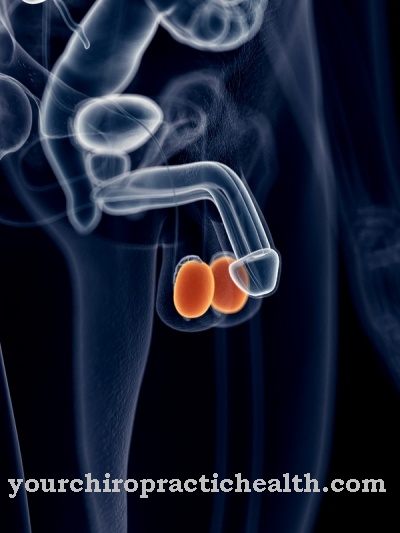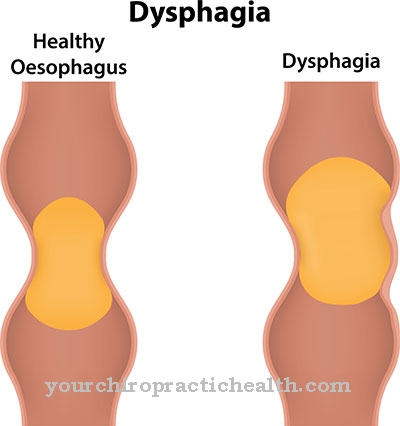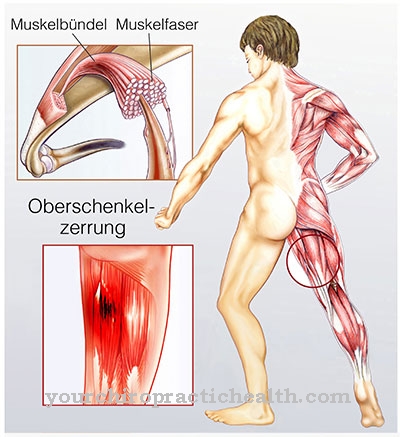Under an existing Visual impairment Not only adults of different age groups suffer. Even very young children and newborns can develop visual impairment.
What is a visual impairment?

© Stefan_Weis - stock.adobe.com
As one Visual impairment a more or less intense impairment of sight or the ability of visual perception is considered.
A visual impairment usually lasts for life without treatment and is based on a wide variety of functional limitations of the eye and the nerves involved in seeing. In this context, the visual impairment occurs as blindness or as partial loss of sight.
In the case of partial visual impairment, visual stimuli can still be picked up, so that the quality of life of those affected in these cases is limited, but higher than that of a blind person. The chances of recovery for visual impairment depend on the causes and triggers.
causes
The causes that lead to a Visual impairment can lead to different aspects. These relate to diseases of the eye, the brain or the nerves, which can have organic or functional impairments.
This contributes to the fact that people "can see poorly". Typical causes of visual impairment are damage to the retina from existing diabetes mellitus and permanently high sugar levels, a decline in the macula, glaucoma or cataracts. A visual impairment can also be a secondary disease of a stroke, tumor growth or an injury to the skull including the brain.
The most common causes of visual impairment are cloudiness of the lens of the eye (cataract), damage to the optic nerve due to abnormal intraocular pressure (glaucoma) or degenerative processes in the retina. Diabetic retinopathy is also of prophylactic importance in the visual impairment.
Symptoms, ailments & signs
A visual impairment always shows itself as a visual impairment - either in general or in certain situations. In addition, the restriction can increase over time. The symptoms of a visual impairment are seen in relative terms. An existing visual impairment, such as myopia, for example, can lead to a further visual impairment.The symptoms always consist of a deterioration in the current vision.
For example, nearsightedness or farsightedness can occur, which is primarily expressed in the fact that the point of sharpest vision shifts. This means that either near or far objects can no longer be seen clearly. Both conditions usually get worse over time. Myopia often occurs in childhood.
Other forms of visual impairment include, for example, night blindness or problems with color vision. A distinction can be made between color blindness and complete color blindness. The most serious visual impairment is the appearance of blindness, which can either be acute or develop as a result of illness.
Furthermore, any restrictions in the field of vision that occur are also considered to be visual impairments. This can lead to a reduction in the field of view, impaired vision or problems with processing stimuli. In all cases, the affected person's eyesight is restricted by various disruptive factors.
Diagnosis & course
The forms of the Visual impairment are always determined by the causal triggers. Basically, those affected suffer less from pain and more from a decrease in vision (sharpness) or from a limitation of the face or field of vision.
In some cases, visual impairment or blindness is inherent. If left untreated, visual impairment leads to a deterioration in vision.
The diagnosis of visual impairment includes the description of the impairments caused by the patient and special abnormalities. These are, for example, headaches, watery eyes, blurred vision and other peculiarities.
In addition, a screening examination, an assessment of the visual field, the measurement of the intraocular pressure, the so-called fundus and skiascopy serve as proven classic diagnostic and differential diagnostic procedures for the visual impairment.
Complications
A visual impairment can of course have different degrees of severity, so that possible complications can be very different. If one assumes a complete visual impairment, the person concerned is of course very limited in everyday life. If there is complete visual impairment, then there are often considerable disorientation, dizziness and long-lasting nausea.
People who have recently suffered from visual impairment must first learn to deal with it. The simplest things suddenly become a great challenge, so that under certain circumstances psychological problems and stress can also arise. Of course, visual impairment can occur suddenly and unexpectedly.
People who suffer from a sudden visual impairment are initially overwhelmed by the overall situation. In some cases, visual impairment is caused due to an infection in the eye, which of course is also associated with various complications. There may be excessive pus production, making the eye sticky and severely impaired.
If such a clinical picture remains untreated, further complications can arise. Increased pus production and long-lasting headaches are possible side effects that can become increasingly worse if left untreated.
When should you go to the doctor?
If you have a visual impairment, you should always consult a doctor. There is no self-healing and the symptoms usually worsen if no treatment is initiated. Only with a correct diagnosis and treatment of the visual impairment can further complications or, in the worst case, complete blindness be prevented. A doctor should be consulted if the person concerned suffers from visual problems. These usually occur for no particular reason and do not go away on their own. This can be poor eyesight, blurred vision or a squint. A doctor should also be consulted with color blindness, as this usually does not go away on its own.
If you have visual impairment, you should see an ophthalmologist. A visual impairment cannot always be treated, so that in some cases those affected are dependent on visual aids for life.
Treatment & Therapy
The selection of the correct therapeutic method is determined by various factors which are involved in the Visual impairment must be observed.
Within the entire range of therapies for visual impairment, the optimal conditions exist to initially find suitable aids. These are glasses or contact lenses to reduce visual impairment. For glaucoma or cataracts, surgical interventions against a visual impairment are predominantly considered. Laser therapy is useful for so-called premature retinopathies. Detected tumors are fought with a visual impairment with radiation or chemotherapy.
An increase in vision in the event of a visual impairment can be achieved on the basis of so-called occlusion therapy. In addition, a visual impairment can also be treated to a certain extent by correcting an astigmatism.
Corneal implantation Retinal lasers have become common nowadays as a therapy for a visual impairment. Severe visual impairments can usually no longer be treated adequately because the deterioration of the eyesight has progressed too far.
You can find your medication here
➔ Medicines for visual disturbances and eye complaintsprevention
A prevention against an acquired Visual impairment is based on regular eye check-ups. Diabetics should ensure that their blood sugar level is professionally adjusted and have their eyes checked regularly to prevent visual impairment.
Mechanisms that can be integrated into everyday life are also important in order to protect the eyes and avoid visual impairment. Workplaces with anti-glare screens, optimal light for the eyes, wearing sun glasses and protective goggles, keeping the correct distance when reading and reducing stressors in everyday life are helpful in avoiding visual impairment.
In principle, however, not all visual impairments can be prevented. For example, some visual impairments are triggered by advancing age.
Aftercare
In many cases, the follow-up measures for a visual impairment are severely limited, and in some cases they are not even available to the person affected. Therefore, the person affected should ideally consult a doctor at the first signs and symptoms of these diseases so that there are no other complaints or complications.
As a rule, self-healing cannot occur with a visual impairment. Some of the symptoms can be relieved and treated relatively well with a visual aid. In doing so, however, the person affected should ensure that they always wear and use these visual aids regularly, as otherwise the visual acuity can decrease again.
The further course of the visual impairment is very much dependent on the exact type and severity, so that a general course cannot be predicted. In serious cases, those affected are sometimes dependent on the help and care of relatives and friends. This can make everyday life much easier for the person affected. A visual impairment does not usually reduce the life expectancy of the person affected, although a general prediction cannot be made here.
You can do that yourself
The visual impairment is of course primarily taken care of by the treating ophthalmologist and the optician. Nevertheless, self-help is also very important in everyday life, especially if the visual impairment is severe. Self-help groups, doctors and opticians are valuable points of contact for receiving tips for self-help. The exchange of like-minded people with the same problems is of great importance. Self-help groups are often superior to medical institutions because of the regularity of visits and the information they provide.
Visual disturbances can be easily compensated for with a magnifying glass, especially with small print. The magnifying glass at home can always be close at hand. In supermarkets, magnifying glasses are often attached to the shopping trolleys and make it possible to read the prices as well as the information on a package.
With the computer, the font can be set larger in no time, so that reading small letters does not have to be expected of the visually impaired. For children and adolescents whose poor eyesight has only just been discovered, ophthalmologists offer vision schools that can bring good results. It is also important to give your eyes some rest and a break from time to time. Constant work on the screen has to be interrupted every now and then and even when driving a car you need a break to give tired eyes relaxation.

.jpg)






















.jpg)



